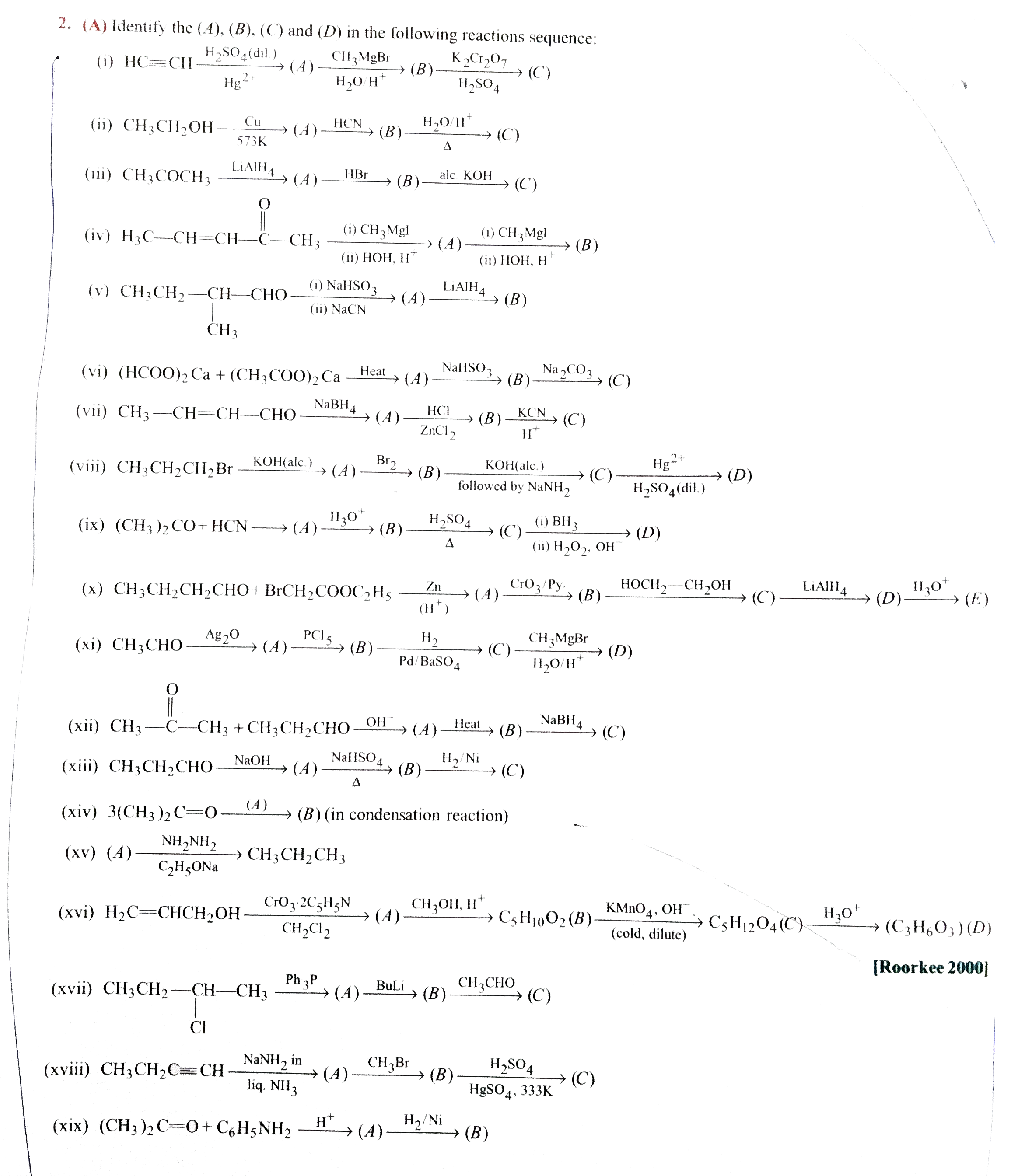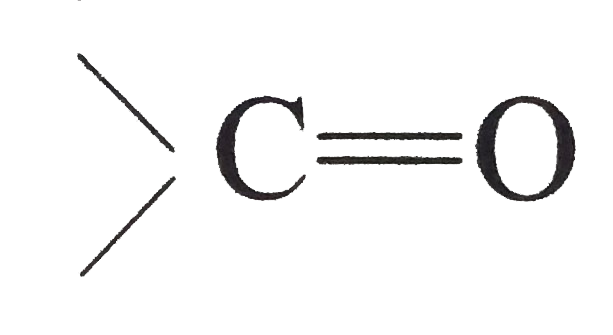Complete Solutions to PROBLEMS FOR PRACTICE of chapter ALDEHYDES AND KETONES of Class 12 book with complete answers and questions
| Class 12 | CHEMISTRY |
| Chapter | ALDEHYDES AND KETONES |
| OP TANDON | PROBLEMS FOR PRACTICE |
| Number Of Questions | 14 |
| Academic Year | 2023-24 |
Complete the following equations and write down the names of the products :

 View Solution
View SolutionIdentify the (A),(B),(C) and (D) in the following reactions sequence:


 View Solution
View SolutionWhat happens when (Give equation only)
(i) Calcium acetate is heated.
(ii) Acetaldehyde is heated with aqueous sodium hydroxide solution
(iii) Formaldehyde reacts with sodium hydroxide.
(iv) Acetone is treated with HCN and the products is boiled with an acid.
(v) Formaldehyde is treated with methyl magnesium bromide and the product is then hydrolysed.
(vi) Ammonia reacts with formaldehyde.
(vii) Ammonia reacts with acetone
(vii) Chloral is heated with aquesous sodium hydroxide.
(ix) Acetdehyde reacts with Fehling's solution
(x) Acetone is deistilled with conc. `H_(2)SO_(4)`View Solution(i) Givean industrial preparation of (a) formaldehyde, (b) acetaldehyde and (c) acetone
(ii) Give the methods by which ethyl alcohol may be converted into acetaldehyde
(iii) How is an aldehyde obtained from an acid chloride?
(iv) Write an equation for making aldehydes by the oxo process.
(v) How is impure acetaldehyde purified? ltbr (vi) How is impure acetone purified?08:47View Solution(a) Whrite the structural formulae and give the IUPAC names for all the aldehydes and ketones of molecular formula, `C_(5)H_(10)O.`
(b) Write the function isomers of `C_(5)H_(10)O`, that can give Cannizzarpo's reaction
(c) A keto ester, `C_(6)H_(10)O_(3)` that forms oxime and by iodoform test ( with`I_(2)` and NaOH) forms `CH_(2)(COONa)_(2)` and structure07:34View SolutionHow will you differentiate between?
(i) Aceetaldehyde and acetone.
(ii) Aldehydes and ketones with (i) Tollens's regent (ii) Fehling's solution
(iii) Acetone and diethyl ether
(iv) Formaldehyde and acetaldehyde.
(v) Ethyl alcohol and acetone
(vi) Formaldehyde and ethyl alcohol
(vii) Pentan-2-one and pentan-3-one
(viii) Benzaldehyde and acetophenone
(ix) Benzaldehyde and acetaldehyde ltbr (x) Benzaldehyde and introbenzene.View SolutionWhich of the following compounds would undergo aldol condensation or the Cannizzaro reaction, or neither? Writer the structures of expected products of aldol condensation and Cannizzaro reaction.
i. Methanal ii. 2-Methylpentanal
iii. Benzaldehyde iv. Benzophenone
v. Cyclohexanone vi. 1-Phenylpropanone
vii. Phenylacetaldehye viii. Butan-1-ol
ix. 2,2-Dimethylbutanal12:57View SolutionHow do you account for the following ?
(a) Boilling points of aldehydes lie between parent alkanes
(b) Aldehydes and ketones have high dipole moments
(c) `NaHSO_(3)` is used for the purification aldehydes and ketones
(d) Iodoforms is obtained byt he reactionof acetone with hypoiodite but not with iodide
(e) Hydrazones of aldehydes and ketones are not prepared in highly acidic mediumView SolutionExplain the following with proper reasonin
(i) Why do halogen acids which are easily added to
(ii) Pure HCN fails to react with aldehydes.
(iii) Why only RCHO, `RCOCH_(3)` and cyclic ketones react with `NaHSO_(3)`?
(iv) Chloral hydrate is a stable compound even it is a gem-diol.
(v) Formation of oximes and other ammonia derivatives from carbonyl compounds require slightly acidic media for maxiumum rate
(vi) In the following reaction, three isomers are present in the equilibrium which is most stable

(vii) teh strurcture of two isomeric oximes formed by the reaction of acetophenon with hydroxylamine hydrochloride.
(viii) Why o-hydroxy benzaldehyde is a liquid at room temperature while p-hydroxy benzaldehyde is high metling solid?View SolutionArrange the following
(i) `-CHO,-COCH_(3),-COOH,-COCl,-CONH_(2),-COOCH_(3),-COO^(-)` in dereasing order of nucleophilic addition.
(ii) `CH_(3)CHO,CH_(3)COCH_(3),HCHO,C_(2)H_(5)COCH_(3)` in decreasing order of nucleophilic addition.
(iii)`CH_(3)COCH_(2)CHO,CH_(3)COCH_(3),CH_(3)CHO,CH_(3)COCH_(2)COCH_(3)` in increasing order of expected enol content.
(iv) `CH_(3)CHO,C_(6)H_(5)CHO,(CH_(3))CO,FCH_(2)CHO` in decreasing order of reactivity

in decreasing order of reactivityView SolutionWrite structure formulae and names of four possible aldol condensation products form propanal and butanal. In each case. Indicate which aldehyde acts as nucleophile and which as electrophile.
07:30View SolutionName the following reactants and also give the names of reactions involved.
 22:55View Solution
22:55View SolutionIdentify (A), (B), (C ), (D), and (E ) in the following reactions and write their structures.
 `overset(Br_(2)//C CI_(4))rarr` (A) `overset(NaNH_(2))rarr` (B) `overset(HgSO_(4))underset(H_(2)SO_(4))rarr` (C )
`overset(Br_(2)//C CI_(4))rarr` (A) `overset(NaNH_(2))rarr` (B) `overset(HgSO_(4))underset(H_(2)SO_(4))rarr` (C )
`(C )overset(NH_(2)NHCONH_(2))rarr(D)`
`(C )overset(NaOD//D_(2)O("Excess"))rarr(E )`06:39View SolutionWrite the intermediate steps in the following reaction :
`C_(6)H_(5)CH(OH)-C-=CHoverset(H_(3)O^(+))rarrC_(6)H_(5)CH=CHCHO`03:01View Solution
PROBLEMS FOR PRACTICE questions and complete solutions for chapter ALDEHYDES AND KETONES of G.R. BATHLA & SONS CHEMISTRY (HINGLISH) of Class 12
All Exercises from OP TANDON Class 12 CHEMISTRY ALDEHYDES AND KETONES
- ASSERTION-REASON TYPE QUESTIONS
- BRAIN STORMIN PROBLEMS
- ILLUSTRATIONS OF OBJECTIVE QUESTIONS
- MATCHING TYPE
- MATRIX-MATCH TYPE QUESTIONS
- OBJECTIVE QUESTIONS (LEVEL -A)
- OBJECTIVE QUESTIONS (LEVEL -B) SET I
- OBJECTIVE QUESTIONS (LEVEL -B) SET II
- PASSAGE 1
- PASSAGE 2
- PASSAGE 3
- PASSAGE 4
- PASSAGE 5
- PASSAGE 6
- PASSAGE 7
- PASSAGE 8
- PROBLEMS BASED ON STRUCTURE AND PROPETIES
- PROBLEMS FOR PRACTICE
- SINGLE INTEGER ANSWER TYPE QUESTIONS
- SOME SOLVED PROBLEMS
